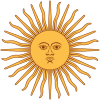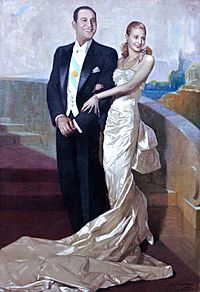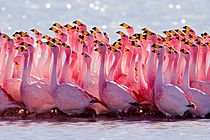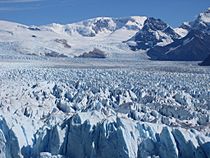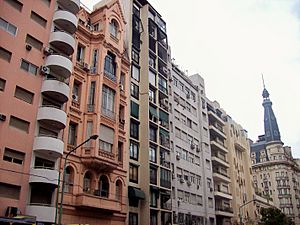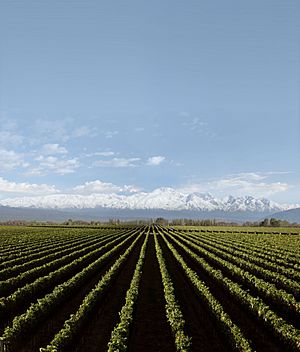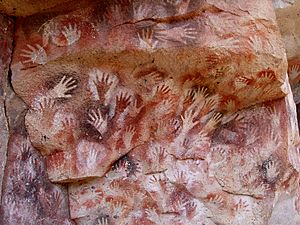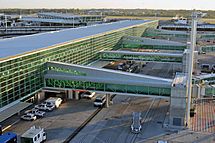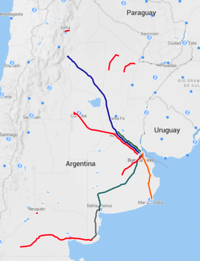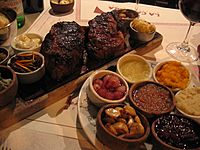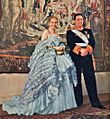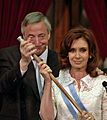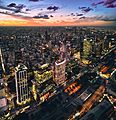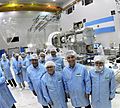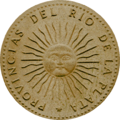Argentina facts for kids
Quick facts for kids
Argentine Republic
República Argentina (Spanish)
|
|
|---|---|
|
Motto:
|
|
|
Anthem: Himno Nacional Argentino
("Argentine National Anthem") |
|
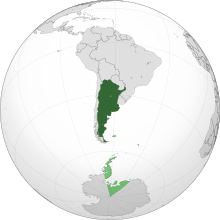
Argentine territory in dark green; territory claimed but not controlled by Argentina in light green
|
|
| Capital and largest city
|
Buenos Aires 34°36′S 58°23′W / 34.600°S 58.383°W |
| Official languages | Spanish |
| Co-official languages |
|
| Religion
(2022)
|
|
| Demonym(s) |
|
| Government | Federal presidential constitutional republic |
| Javier Milei | |
| Victoria Villarruel | |
|
• Chief of the Cabinet of Ministers
|
Nicolás Posse |
| Legislature | National Congress |
| Senate | |
| Chamber of Deputies | |
| Independence
from Spain
|
|
| 25 May 1810 | |
|
• Declared
|
9 July 1816 |
| 1 May 1853 | |
| Area | |
|
• Total
|
2,780,400 km2 (1,073,500 sq mi) (8th) |
|
• Water (%)
|
1.57 |
| Population | |
|
• 2022 census
|
47,327,407 (31st) |
|
• Density
|
14.4/km2 (37.3/sq mi) (178th) |
| GDP (PPP) | 2023 estimate |
|
• Total
|
|
|
• Per capita
|
|
| GDP (nominal) | 2023 estimate |
|
• Total
|
|
|
• Per capita
|
|
| Gini (2020) | ▼ 42.3 medium |
| HDI (2021) | very high · 47th |
| Currency | Argentine peso ($) (ARS) |
| Time zone | UTC−3 (ART) |
| Date format | dd/mm/yyyy (CE) |
| Driving side | right |
| Calling code | +54 |
| ISO 3166 code | AR |
| Internet TLD | .ar |
|
|
|
Argentina (officially the Argentine Republic) is a country in South America. Argentina is the second-largest country in South America and the eighth-largest country in the world.
Spanish is the language most people speak and the official language, but many other languages are spoken. There are minorities speaking Italian, German, English, Quechua and even Welsh in Patagonia.
The capital city of the Argentina is Buenos Aires, one of the largest cities in the world, in eastern Argentina. In order by number of people, the largest cities in Argentina are Buenos Aires, Córdoba, Rosario, Mendoza, La Plata, Tucumán, Mar del Plata, Salta, Santa Fe, and Bahía Blanca.
Argentina is between the Andes mountain range in the west and the southern Atlantic Ocean in the east and south. It is bordered by Paraguay and Bolivia in the north, Brazil and Uruguay in the northeast, and Chile in the west and south. It also claims the Falkland Islands (Spanish: Islas Malvinas) and South Georgia and the South Sandwich Islands.
Contents
History
The name Argentina comes from the Latin argentum (silver) as the Spanish conquistadors believed the area had silver. In the Americas, Canada, US, Brazil and Argentina are the largest countries (in that order).
The oldest signs of people in Argentina are in the Patagonia (Piedra Museo, Santa Cruz), and are more than 13,000 years old. In 1480 the Inca Empire conquered northwestern Argentina, making it part of the empire. In the northeastern area, the Guaraní developed a culture based on yuca and sweet potato however typical dishes all around Argentina are pasta, red wines (Italian influence) and beef.
Other languages spoken are Italian, English and German. Lunfardo is Argentinean slang and is a mix of Spanish and Italian. Argentineans are said to speak Spanish with an Italian accent.
Argentina declared independent from Spain in 1816, and achieved it in 1818. It grew a lot after immigrants from Europe came to the country. By the 1920s it was the 7th wealthiest country in the world, but it began a decline after this. In the 1940s, following the "infamous decade" where the country's politics were not stable, Juan Peron came to power. Peron was one of the most important people in the country's history and many politicians today call themselves Peronist. Peron was forced out of power in 1955. After spending years in exile he returned to power in the 1970s.
In 1976, the country was falling into chaos, and the military took power. This was not the first time the military had done this. Leading the new government was Jorge Rafael Videla. Videla was one of history's most brutal dictators. Thousands of people disappeared or were killed during his time as president. Videla retired in 1980.
One of his successors was another general turned dictator, Leopoldo Galtieri. By the time Galtieri was in office in 1981 the dictatorship became unpopular. To try to stir up support, Galtieri ordered an invasion of the Falkland Islands, starting a war. Argentina lost the war, and soon the country fell into chaos again. Galtieri was removed from power and eventually democracy was restored. Galtieri and Videla would be charged with "crimes against humanity" because of the mass murder and other crimes that they ordered as president.
Today, Argentina is one of the most important countries in Latin America, though it still has many problems facing it. It has a large economy and is an influential country in the "southern cone" of South America.
Geography
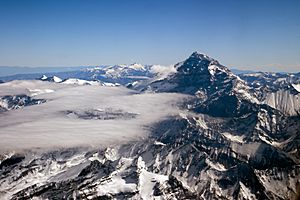
With a mainland surface area of 2,780,400 km2 (1,073,518 sq mi), Argentina is located in southern South America, sharing land borders with Chile across the Andes to the west; Bolivia and Paraguay to the north; Brazil to the northeast, Uruguay and the South Atlantic Ocean to the east; and the Drake Passage to the south; for an overall land border length of 9,376 km (5,826 mi). Its coastal border over the Río de la Plata and South Atlantic Ocean is 5,117 km (3,180 mi) long.
Argentina's highest point is Aconcagua in the Mendoza province (6,959 m (22,831 ft) above sea level), also the highest point in the Southern and Western Hemispheres. The lowest point is Laguna del Carbón in the San Julián Great Depression Santa Cruz province (−105 m (−344 ft) below sea level, also the lowest point in the Southern and Western Hemispheres, and the seventh lowest point on Earth)
The northernmost point is at the confluence of the Grande de San Juan and Río Mojinete rivers in Jujuy province; the southernmost is Cape San Pío in Tierra del Fuego province; the easternmost is northeast of Bernardo de Irigoyen, Misiones and the westernmost is within Los Glaciares National Park in Santa Cruz province. The maximum north–south distance is 3,694 km (2,295 mi), while the maximum east–west one is 1,423 km (884 mi).
Some of the major rivers are the Paraná, Uruguay—which join to form the Río de la Plata, Paraguay, Salado, Negro, Santa Cruz, Pilcomayo, Bermejo and Colorado. These rivers are discharged into the Argentine Sea, the shallow area of the Atlantic Ocean over the Argentine Shelf, an unusually wide continental platform. Its waters are influenced by two major ocean currents: the warm Brazil Current and the cold Falklands Current.
Regions
Argentina is divided into seven geographical regions:
- Northwest, a continuation of the high Puna with even higher, more rugged topography to the far-west; the arid precordillera, filled with narrow valleys or quebradas to the mid-west; and an extension of the mountainous Yungas jungles to the east.
- Mesopotamia, a subtropical wedge covering the western Paraná Plateau and neighboring lowlands enclosed by the Paraná and Uruguay rivers.
- Gran Chaco, a large, subtropical and tropical low-lying, gently sloping alluvial plain between Mesopotamia and the Andes.
- Sierras Pampeanas, a series of medium-height mountain chains located in the center.
- Cuyo, a basin and range area in the central Andes piedmont, to the west.
- Pampas, a massive and hugely fertile alluvial plain located in the center east.
- Patagonia, a large southern plateau consisting mostly of arid, rocky steppes to the east; with moister cold grasslands to the south and dense subantarctic forests to the west.
Biodiversity
Argentina is a megadiverse country hosting one of the greatest ecosystem varieties in the world: 15 continental zones, 3 oceanic zones, and the Antarctic region are all represented in its territory. This huge ecosystem variety has led to a biological diversity that is among the world's largest:
- 9,372 cataloged vascular plant species (ranked 24th)
- 1,038 cataloged bird species (ranked 14th)
- 375 cataloged mammal species (ranked 12th)
- 338 cataloged reptilian species (ranked 16th)
- 162 cataloged amphibian species (ranked 19th)
Climate
Although the most populated areas are generally temperate, Argentina has an exceptional amount of climate diversity, ranging from subtropical in the north to polar in the far south. The average annual precipitation ranges from 150 millimetres (6 in) in the driest parts of Patagonia to over 2,000 millimetres (79 in) in the westernmost parts of Patagonia and the northeastern parts of the country. Mean annual temperatures range from 5 °C (41 °F) in the far south to 25 °C (77 °F) in the north.
Major wind currents include the cool Pampero Winds blowing on the flat plains of Patagonia and the Pampas; following the cold front, warm currents blow from the north in middle and late winter, creating mild conditions. The Sudestada usually moderates cold temperatures but brings very heavy rains, rough seas and coastal flooding. It is most common in late autumn and winter along the central coast and in the Río de la Plata estuary. The Zonda, a hot dry wind, affects Cuyo and the central Pampas. Squeezed of all moisture during the 6,000 m (19,685 ft) descent from the Andes, Zonda winds can blow for hours with gusts up to 120 km/h (75 mph), fueling wildfires and causing damage; between June and November, when the Zonda blows, snowstorms and blizzard (viento blanco) conditions usually affect higher elevations.
Demographics
In 2001, Argentina had a population of 36,260,130, and preliminary results from the 2010 census were of 40,091,359 inhabitants. Argentina ranks third in South America in total population and 33rd globally.
The majority of the Argentineans are descendants of Europeans mainly from Spain, Italy, Germany, Ireland, France, other Europeans countries and Mestizo representing more than 90% of the total population of the country.
Economy
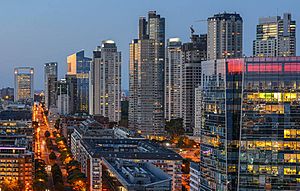
Benefiting from rich natural resources, a highly literate population, a diversified industrial base, and an export-oriented agricultural sector, the economy of Argentina is Latin America's third-largest, and the second largest in South America.

A middle emerging economy and one of the world's top developing nations, Argentina is a member of the G-20 major economies.
Industry
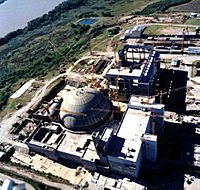
In 2012[update] the leading sectors by volume were: food processing, beverages and tobacco products; motor vehicles and auto parts; textiles and leather; refinery products and biodiesel; chemicals and pharmaceuticals; steel, aluminum and iron; industrial and farm machinery; home appliances and furniture; plastics and tires; glass and cement; and recording and print media.
In addition, Argentina has since long been one of the top five wine-producing countries in the world.
Córdoba is Argentina's major industrial center, hosting metalworking, motor vehicle and auto parts manufactures. Next in importance are the Greater Buenos Aires area (food processing, metallurgy, motor vehicles and auto parts, chemicals and petrochemicals, consumer durables, textiles and printing); Rosario (food processing, metallurgy, farm machinery, oil refining, chemicals, and tanning); San Miguel de Tucumán (sugar refining); San Lorenzo (chemicals and pharmaceuticals); San Nicolás de los Arroyos (steel milling and metallurgy); and Ushuaia and Bahía Blanca (oil refining). Other manufacturing enterprises are located in the provinces of Santa Fe (zinc and copper smelting, and flour milling); Mendoza and Neuquén (wineries and fruit processing); Chaco (textiles and sawmills); and Santa Cruz, Salta and Chubut (oil refining)
The electric output of Argentina in 2009[update] totaled over 122 TWh (440 PJ), of which about 37% was consumed by industrial activities.
Tourism
Tourism in Argentina is characterized by its cultural offerings and its ample and varied natural assets. The country had 5.57 million visitors in 2013, ranking in terms of the international tourist arrivals as the top destination in South America, and second in Latin America after Mexico. Revenues from international tourists reached US$4.41 billion in 2013, down from US$4.89 billion in 2012. The country's capital city, Buenos Aires, is the most visited city in South America. There are 30 National Parks of Argentina including many World Heritage Sites in Argentina.
Top sights in Argentina
- Iguazu Falls
- Teatro Colón
- Obelisk of Buenos Aires
- Cementerio de la Recoleta
- Casa Rosada
- Plaza de Mayo
- Palacio Barolo
- National Flag Memorial
- Perito Moreno Glacier
- National Museum of Decorative Arts
- Cueva de las Manos
Transport
Argentina has the largest railway system in Latin America, with 36,966 km (22,970 mi) of operating lines in 2008[update], out of a full network of almost 48,000 km (29,826 mi). This system links all 23 provinces plus Buenos Aires City, and connects with all neighboring countries.
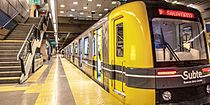
By 2004[update] Buenos Aires, all provincial capitals except Ushuaia, and all medium-sized towns were interconnected by 69,412 km (43,131 mi) of paved roads, out of a total road network of 231,374 km (143,769 mi). Most important cities are linked by a growing number of expressways.
In 2012[update] there were about 11,000 km (6,835 mi) of waterways, mostly comprising the La Plata, Paraná, Paraguay and Uruguay rivers, with Buenos Aires, Zárate, Campana, Rosario, San Lorenzo, Santa Fe, Barranqueras and San Nicolas de los Arroyos as the main fluvial ports. Some of the largest sea ports are La Plata–Ensenada, Bahía Blanca, Mar del Plata, Quequén–Necochea, Comodoro Rivadavia, Puerto Deseado, Puerto Madryn, Ushuaia and San Antonio Oeste. Buenos Aires has historically been the most important port; however since the 1990s the Up-River port region has become dominant: stretching along 67 km (42 mi) of the Paraná river shore in Santa Fe province, it includes 17 ports and in 2013[update] accounted for 50% of all exports.
In 2013[update] there were 161 airports with paved runways out of more than a thousand.
Culture
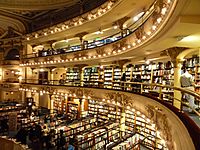
Argentina is a multicultural country with significant European influences. Modern Argentine culture has been largely influenced by Italian, Spanish and other European immigration from France, United Kingdom, and Germany among others. Its cities are largely characterized by both the prevalence of people of European descent, and of conscious imitation of American and European styles in fashion, architecture and design. Museums, cinemas, and galleries are abundant in all the large urban centers, as well as traditional establishments such as literary bars, or bars offering live music of a variety of genres although there are lesser elements of Amerindian and African influences, particularly in the fields of music and art. The other big influence is the gauchos and their traditional country lifestyle of self-reliance. Finally, indigenous American traditions have been absorbed into the general cultural milieu.
Music
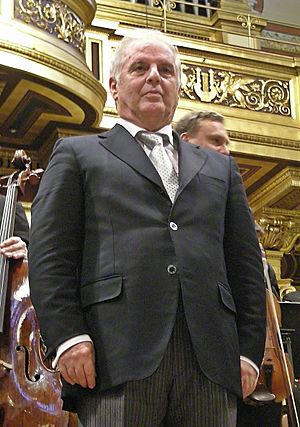
Tango, a Rioplatense musical genre with European and African influences, is one of Argentina's international cultural symbols. The golden age of tango (1930 to mid-1950s) mirrored that of jazz and swing in the United States, featuring large orchestras.
Architecture
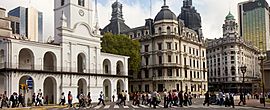
The colonization brought the Spanish Baroque architecture, which can still be appreciated in its simpler Rioplatense style in the reduction of San Ignacio Miní, the Cathedral of Córdoba, and the Cabildo of Luján. Italian and French influences increased at the beginning of the 19th century with strong eclectic overtones that gave the local architecture a unique feeling.
Cuisine
Besides many of the pasta, sausage and dessert dishes common to continental Europe, Argentines enjoy a wide variety of Indigenous and Criollo creations, including empanadas (a small stuffed pastry), locro (a mixture of corn, beans, meat, bacon, onion, and gourd), humita and mate.
The country has the highest consumption of red meat in the world, traditionally prepared as asado, the Argentine barbecue. It is made with various types of meats, often including chorizo, sweetbread, chitterlings, and blood sausage.
Common desserts include facturas (Viennese-style pastry), cakes and pancakes filled with dulce de leche (a sort of milk caramel jam), alfajores (shortbread cookies sandwiched together with chocolate, dulce de leche or a fruit paste), and tortas fritas (fried cakes)
Argentine wine, one of the world's finest, is an integral part of the local menu. Malbec, Torrontés, Cabernet Sauvignon, Syrah and Chardonnay are some of the most sought-after varieties.
Other information
Football or soccer is the most popular sport, although the national sport of the country is Pato. Argentina has a number of highly ranked Polo players. Field hockey (for women) rugby and golf are also favorites.
Argentina is a Christian country. Most of Argentina's people (80 percent) are Roman Catholic. Argentina also has the largest population of Jewish community after Israel and US. Many Middle Eastern immigrants who were Muslims converted to Catholicism, but there are still Muslims as well.
Related pages
Images for kids
-
The Cave of the Hands in Santa Cruz province, with artwork dating from 13,000 to 9,000 years ago.
-
Portrait of General José de San Martin, Libertador of Argentina, Chile and Peru.
-
People gathered in front of the Buenos Aires Cabildo during the May Revolution
-
Julio Argentino Roca was a major figure of the Generation of '80 and is known for directing the "Conquest of the Desert". During his two terms as President many changes occurred, particularly major infrastructure projects of railroads; large-scale immigration from Europe and laicizing legislation strengthening state power.
-
Juan Perón and his wife Eva Perón, 1947
-
Juan Perón and his wife Isabel Perón, 1973
-
Admiral Emilio Massera, Lieutenant General Jorge Videla and Brigadier General Orlando Agosti (from left to right) – observing the Independence Day military parade on Avenida del Libertador, 9 July 1978.
-
Argentinians soldiers during the Falklands War
-
Two members of the Regiment of Mounted Grenadiers guarding the Constitution of the Argentine Nation inside the Palace of the Congress.
-
Néstor Kirchner and his wife and political successor, Cristina Kirchner
-
Aconcagua is the highest mountain outside of Asia, at 6,960.8 metres (22,837 ft), and the highest point in the Southern Hemisphere.
-
The national animal of Argentina is the Rufous hornero, a small songbird native to South America
-
Fiat factory in Córdoba, Argentina
-
Passenger train near Mar del Plata
-
Dialectal variants of the Spanish language in Argentina
-
Francis, the first pope from the Americas, was born and raised in Argentina.
-
Faculty of Law of the University of Buenos Aires
-
El Ateneo Grand Splendid was named the second most beautiful bookshop in the world by The Guardian.
-
Four of the most influential Argentine writers. Top-left to bottom-right: Julio Cortázar, Victoria Ocampo, Jorge Luis Borges and Adolfo Bioy Casares
-
Martha Argerich, widely regarded as one of the greatest pianists of the second half of the 20th century
-
Teatro Colón, ranked the third best opera house in the world.
-
Andy Muschietti, director of It, the highest-grossing horror film of all-time.
-
Las Nereidas Font by Lola Mora
-
Diego Maradona, one of the FIFA Player of the 20th Century
-
Lionel Messi, seven times Ballon d'Or winner, is the current captain of the Argentina national football team.
See also
 In Spanish: Argentina para niños
In Spanish: Argentina para niños




